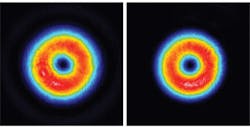HOLLOW-CORE FIBERS: Waveguide mode with dark center becomes atom guide
Guiding atoms, and keeping them away from the walls of the conduit while doing so, is essential in many physics experiments; it also allows quantities of free atoms to be used to produce valuable effects such as slow light. Hollow optical waveguides in the form of optical fibers can guide atoms if the guiding light is slightly detuned from the atomic resonance. For red-detuned light, atoms are pulled toward high intensity, while blue-detuned light draws atoms to low-intensity regions.
Experimentally, each type of detuning has had its own disadvantages. With red detuning (using the fundamental EH11 mode), the high-intensity guiding causes large energy-level shifts in the atoms and more photon scattering. Blue detuning, which has been carried out with evanescent fields (which propagate mostly in the solid cladding and extend only faintly into the hollow core, existing mostly near the cladding boundary) are inefficient; multimode properties can also cause speckle.
A group at the Naval Research Laboratory (NRL; Washington, DC) has overcome these problems, creating a fiber-based atom guide for blue detuning that channels the atoms along the dark center of the waveguide's torus-shaped TE01 mode, which is entirely inside the fiber's hollow core, rather than relying on evanescent modes.1 The group has also developed a simple, stable way to create the TE01 mode.
Silver coating
Starting with a glass fiber having a 50 µm hollow core, the researchers coated the inside with silver in a multistep process, using capillary action to draw the various fluids into the fiber. The hollow core was first coated with silane and then with 8 nm diameter gold nanoparticles; next, the nanoparticle coating was treated by a so-called Tollens reaction, which creates smooth silver films on gold nanoparticle arrays. The result was an 8.1 cm attenuation length for the TE01 mode.
The TE01 input beam was created from a Gaussian laser beam via a technique invented by the researchers, which combines TEM01 and TEM10 laser modes as in some previous approaches, but without the need for an interferometrically stable setup.2 In the technique, a beam with a 780 nm wavelength and polarized at 45° passes through a liquid-crystal spatial light modulator, which introduces a phase delay in two opposite quadrants to only the vertically polarized component of the beam. A subsequent phase plate (a 390 nm layer of silicon nitride on half a quartz wafer) introduces a π phase delay to one half of the beam; the result is a quadrant approximation to a radially polarized field. When the beam is then passed through a pinhole, cleaning the beam up, the outcome is a close approximation to the TE01 mode (see figure).
Funneling atoms
The researchers did not describe any experimental results for actual atom-guiding. But they note that the beam exiting the fiber, which has a divergence of about 16 mrad, closely matches a doughnut-shaped (TEM01) free-space mode; this creates a sort of funnel that could be used to help load atoms from a cold-atom source into the fiber.
The biggest hurdle to propagating beams in small-diameter hollow fibers is the short attenuation length, notes Fredrik Fatemi, one of the NRL researchers. Coatings in fibers with cores of less than 100 µm diameter must be very good if propagation beyond a few tens of centimeters is desired. "First, because the attenuation length scales inversely with the cube of the diameter, an uncoated fiber with 50 µm diameter will be strongly attenuated after only a few centimeters," says Fatemi. "Second, submicron wavelengths will be more sensitive than longer IR wavelengths to roughness in the coatings, leading to higher loss (and, in fact, this is a dominant source of loss). Improvements to coating techniques are certainly desirable and something we are working on. Fortunately, for many atom-optics experiments, short fiber lengths should be fine."
REFERENCES
- F.K. Fatemi et al., Optics Express 18(1), p. 323, (Jan. 5, 2010).
- M. Bashkansky et al., Optics Express 18(1), p. 212 (Jan. 5, 2010).
About the Author
John Wallace
Senior Technical Editor (1998-2022)
John Wallace was with Laser Focus World for nearly 25 years, retiring in late June 2022. He obtained a bachelor's degree in mechanical engineering and physics at Rutgers University and a master's in optical engineering at the University of Rochester. Before becoming an editor, John worked as an engineer at RCA, Exxon, Eastman Kodak, and GCA Corporation.

